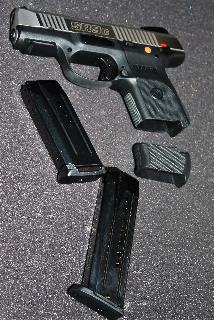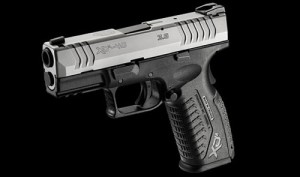Widgetized Section
Go to Admin » Appearance » Widgets » and move Gabfire Widget: Social into that MastheadOverlay zone
Mid-Size the New “Standard”?
Over the past few weeks, I’ve had the opportunity to put several rounds through a couple of new semiauto pistols. Both were pitched as “new” but when I first looked at them, it wasn’t altogether apparent what was new.
Actually, a “couple” isn’t exactly accurate. I’ve had the opportunity to shoot Springfield Armory’s new XD(M) 3.8 – in both 9mm and 40 caliber, along with Ruger’s SR9-C, the “Compact” model of their already slim 9mm.
The Springfield XD-(M) platform started out as a modernization of the popular XD pistol. When the engineers stopped adding features and changing lines, they realized it wasn’t a new version of the pistol, it was almost a new gun. With improvements in the adjustable backstraps, new angles on the slide cuts, a match-grade barrel and other changes, it made the already popular polymer pistol into an even more desirable model.
The new 3.8 units feature a shorter (3.8-inch) barrel, new slide cuts and sleeker slide, turning an already solid performer into a gun that looks almost the same, but behaves different.
I don’t know why- or even how- but the 3.8 unit seems to balance better in my hand. And a better setup equals a better shot.
It may be the fact that it’s neither full-sized nor compact. Instead, it’s mid-sized, and for me, it seems mid-sized is actually “right-sized”. The sight radius is just long enough for me to quickly get a sight picture. On legitimate compacts, including the XD(M), I find myself working to find the front sight. Finding the front sight, especially in a rapid-shooting situation (the kind I practice the most), isn’t something you need to work with.
Otherwise, I found the XD(M) 3.8 to be virtually identical in handling and controls. As I said, the changes in the slide and slide cuts make the 3.8 simple to manipulate for quick racks or press checks. With the XD(M), Springfield made the gun more ergonomic in the push/pull act of racking and cocking; the new cuts and slimmer slide in the 3.8 keep the action simple – and straight front-to-rear. Eliminating the torquing of one hand against the other in a cocking action makes the gun easier to keep level and pointed toward the target.
The difference in the 9mm and the 40 caliber unit, however, was different. In the 9mm, the shorter barrel means very little as far as recoil or recovery. In the 40-cal, however, I found myself battling the sharper recoil and slightly stronger “bark” of the bigger load.
It wasn’t unpleasant and it didn’t cause me any real problems, but as is the case in any platform that’s adapted for different cartridges, different calibers have different characteristics. With the 9mm, I had no problem putting quick double-taps into steel plates. On quick repetitions of double taps in the .40, however, I had to make the conscious effort to hold more firmly on target.
That’s just me- I have a tendency to shoot with “soft” wrists, especially when shooting 9mm and smaller cartridges. It’s a throwback from target shooting with revolvers for many – and thousands of repetitions swinging a golf club, teaching myself to maintain a soft grip so I could “swing easy/hit hard”.
Like the other XD(M) models, the 3.8 comes in the very cool, hard-plastic case that includes, among other things, the extra magazines, holster, mag pouch, and gun lock. It carries an MSRP of $697 in black and $763 in silver/black bi-tone.

- Ruger’s new RR-9 C (compact) pistol. It ships with the smaller 10-round magazine and a new grip adapter that transforms the smaller 9mm into a full 17-rounder. Today, smaller doesn’t necessarily mean lowered capacities.
The Ruger SR-9C is more of a downsized unit than it’s full-sized predecessor. It was already slim and lightweight, but the 9C checks in at 23.4 ounces, is only 6.85 inches long, 4.61 inches high, and the same very slim 1.27-inches in grip width- measured across the safety levers.
It comes with a pair of magazines – and with them, you have two options as to capacity and grip size. The standard 10-round magazine works inside the shortened grip. It also ships with a second floor-plate so you can have a finger extension for a more secure grip.
If you’re looking for more capacity, there’s a grip adapter that slides down on the magazine and brings the capacity to 17-rounds. With that magazine and grip adapter in place, the SR9-C has the same grip size as the full-sized model.
Unlike many polymer pistols, the SR-series features adjustable sights-I’ve not done any tweaking on the units I’ve had, but that’s probably more to do with the fact I’m not looking for fine accuracy in polymer pistols- especially smaller ones.
The C model includes the plethora of safety features that include the 1911-style ambidextrous safety, internal trigger bar interlock and striker blocker, trigger safety and magazine disconnect. It also has the visual/tactile loaded chamber indicator which I either like or dislike, depending on some mood shift I’ve not managed to identify and isolate.
Like the XD(M) 3.8, the SR-9C has the integral light rail. I’ve hung a variety of gear on the lower rail, but prefer the small Insight Technologies X2 light/laser combo.
The biggest difference between the SR9C and it’s larger predecessor seems to be the trigger. The new trigger, according to Ruger officials, has some minor changes, but they seem pretty significant to me. I found the trigger to be considerably more to my liking in the new Compact model.
Both the XD(M) 3.8 and the SR-9C are currently shipping.
I’ve been wondering about the trend toward “mid-sizing” full sized pistols lately, and hadn’t really seen much of a reason behind the decision. I have fired both sizes, and really haven’t seen all that much difference in the combat-shooting type practice I favor (health problems have made me entirely too-shaky for bullseye competition anymore, but I have no problem with larger targets-yet).
That, I’ve realized, might be the reason for what I think might actually be “right-sizing” rather than down-sizing. With the fitting abilities of multiple backstraps and grips on new polymer pistols, the fitting of the gun to the shooter is far more precise.
With a better fit comes – you guessed it- better accuracy and a more comfortable, natural presentation. Since most of us aren’t practicing for precision shooting, shortening the pistol doesn’t radically impact the accuracy, but it does lighten -and shorten- the carry weight and profile.
I’ve carried both the Ruger and Springfield Armory pistols on the belt over the past couple of weeks – and I’m beginning to see the advantages of the smaller size.
And I wouldn’t be surprised at all to see law enforcement departments approving the smaller- “right-sized”- units for duty guns.
We’ll keep you posted.
–Jim Shepherd
www.shootingwire.com




 MidwayUSA
MidwayUSA Ruger Firearms
Ruger Firearms SCCY Firearms
SCCY Firearms Streamlight
Streamlight Action Targets
Action Targets Gunsite Academy
Gunsite Academy
You must be logged in to post a comment Login